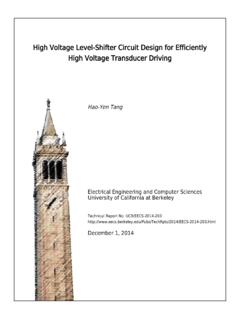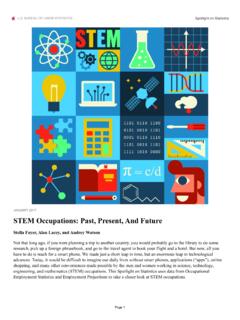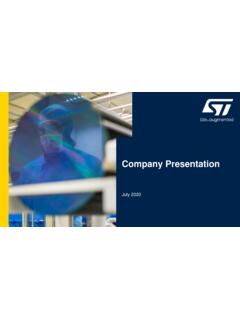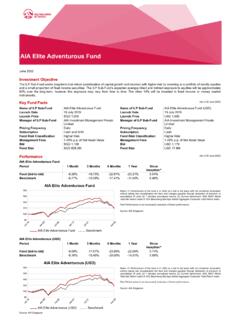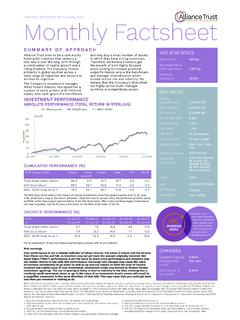Transcription of Above the Clouds: A Berkeley View of Cloud Computing
1 Above the Clouds: A Berkeley view of Cloud Computing Michael Armbrust Armando Fox Rean Griffith Anthony D. Joseph Randy H. Katz Andrew Konwinski Gunho Lee David A. Patterson Ariel Rabkin Ion Stoica Matei Zaharia Electrical Engineering and Computer Sciences University of California at Berkeley Technical Report No. UCB/EECS-2009-28. February 10, 2009. Copyright 2009, by the author(s). All rights reserved. Permission to make digital or hard copies of all or part of this work for personal or classroom use is granted without fee provided that copies are not made or distributed for profit or commercial advantage and that copies bear this notice and the full citation on the first page. To copy otherwise, to republish, to post on servers or to redistribute to lists, requires prior specific permission.
2 Acknowledgement The RAD Lab's existence is due to the generous support of the founding members Google, Microsoft, and Sun Microsystems and of the affiliate members Amazon Web Services, Cisco Systems, Facebook, Hewlett- Packard, IBM, NEC, Network Appliance, Oracle, Siemens, and VMware; by matching funds from the State of California's MICRO program (grants 06- 152, 07-010, 06-148, 07-012, 06-146, 07-009, 06-147, 07-013, 06-149, 06- 150, and 07-008) and the University of California Industry/University Cooperative Research Program (UC Discovery) grant COM07-10240; and by the National Science Foundation (grant #CNS-0509559). Above the Clouds: A Berkeley view of Cloud Computing Michael Armbrust, Armando Fox, Rean Griffith, Anthony D. Joseph, Randy Katz, Andy Konwinski, Gunho Lee, David Patterson, Ariel Rabkin, Ion Stoica, and Matei Zaharia (Comments should be addressed to UC Berkeley Reliable Adaptive Distributed Systems Laboratory.)
3 February 10, 2009. KEYWORDS: Cloud Computing , Utility Computing , Internet Datacenters, Distributed System Economics 1 Executive Summary Cloud Computing , the long-held dream of Computing as a utility, has the potential to transform a large part of the IT industry, making software even more attractive as a service and shaping the way IT hardware is designed and purchased. Developers with innovative ideas for new Internet services no longer require the large capital outlays in hardware to deploy their service or the human expense to operate it. They need not be concerned about over- provisioning for a service whose popularity does not meet their predictions, thus wasting costly resources, or under- provisioning for one that becomes wildly popular, thus missing potential customers and revenue.
4 Moreover, companies with large batch-oriented tasks can get results as quickly as their programs can scale, since using 1000 servers for one hour costs no more than using one server for 1000 hours. This elasticity of resources, without paying a premium for large scale, is unprecedented in the history of IT. Cloud Computing refers to both the applications delivered as services over the Internet and the hardware and systems software in the datacenters that provide those services. The services themselves have long been referred to as Software as a Service (SaaS). The datacenter hardware and software is what we will call a Cloud . When a Cloud is made available in a pay-as-you-go manner to the general public, we call it a Public Cloud ; the service being sold is Utility Computing .
5 We use the term Private Cloud to refer to internal datacenters of a business or other organization, not made available to the general public. Thus, Cloud Computing is the sum of SaaS and Utility Computing , but does not include Private Clouds. People can be users or providers of SaaS, or users or providers of Utility Computing . We focus on SaaS Providers ( Cloud Users) and Cloud Providers, which have received less attention than SaaS Users. From a hardware point of view , three aspects are new in Cloud Computing . 1. The illusion of infinite Computing resources available on demand, thereby eliminating the need for Cloud Com- puting users to plan far ahead for provisioning. 2. The elimination of an up-front commitment by Cloud users, thereby allowing companies to start small and increase hardware resources only when there is an increase in their needs.
6 3. The ability to pay for use of Computing resources on a short-term basis as needed ( , processors by the hour and storage by the day) and release them as needed, thereby rewarding conservation by letting machines and storage go when they are no longer useful. We argue that the construction and operation of extremely large-scale, commodity-computer datacenters at low- cost locations was the key necessary enabler of Cloud Computing , for they uncovered the factors of 5 to 7 decrease in cost of electricity, network bandwidth, operations, software, and hardware available at these very large economies The RAD Lab's existence is due to the generous support of the founding members Google, Microsoft, and Sun Microsystems and of the affiliate members Amazon Web Services, Cisco Systems, Facebook, Hewlett-Packard, IBM, NEC, Network Appliance, Oracle, Siemens, and VMware.
7 By matching funds from the State of California's MICRO program (grants 06-152, 07-010, 06-148, 07-012, 06-146, 07-009, 06-147, 07-013, 06-149, 06-150, and 07-008) and the University of California Industry/University Cooperative Research Program (UC Discovery) grant COM07-10240; and by the National Science Foundation (grant #CNS-0509559). 1. of scale. These factors, combined with statistical multiplexing to increase utilization compared a private Cloud , meant that Cloud Computing could offer services below the costs of a medium-sized datacenter and yet still make a good profit. Any application needs a model of computation, a model of storage, and a model of communication. The statistical multiplexing necessary to achieve elasticity and the illusion of infinite capacity requires each of these resources to be virtualized to hide the implementation of how they are multiplexed and shared.
8 Our view is that different utility Computing offerings will be distinguished based on the level of abstraction presented to the programmer and the level of management of the resources. Amazon EC2 is at one end of the spectrum. An EC2 instance looks much like physical hardware, and users can control nearly the entire software stack, from the kernel upwards. This low level makes it inherently difficult for Amazon to offer automatic scalability and failover, because the semantics associated with replication and other state management issues are highly application-dependent. At the other extreme of the spectrum are application domain- specific platforms such as Google AppEngine. AppEngine is targeted exclusively at traditional web applications, enforcing an application structure of clean separation between a stateless computation tier and a stateful storage tier.
9 AppEngine's impressive automatic scaling and high-availability mechanisms, and the proprietary MegaStore data storage available to AppEngine applications, all rely on these constraints. Applications for Microsoft's Azure are written using the .NET libraries, and compiled to the Common Language Runtime, a language-independent managed environment. Thus, Azure is intermediate between application frameworks like AppEngine and hardware virtual machines like EC2. When is Utility Computing preferable to running a Private Cloud ? A first case is when demand for a service varies with time. Provisioning a data center for the peak load it must sustain a few days per month leads to underutilization at other times, for example. Instead, Cloud Computing lets an organization pay by the hour for Computing resources, potentially leading to cost savings even if the hourly rate to rent a machine from a Cloud provider is higher than the rate to own one.
10 A second case is when demand is unknown in advance. For example, a web startup will need to support a spike in demand when it becomes popular, followed potentially by a reduction once some of the visitors turn away. Finally, organizations that perform batch analytics can use the cost associativity of Cloud Computing to finish computations faster: using 1000 EC2 machines for 1 hour costs the same as using 1 machine for 1000 hours. For the first case of a web business with varying demand over time and revenue proportional to user hours, we have captured the tradeoff in the equation below. Costdatacenter UserHourscloud (revenue Costcloud ) UserHoursdatacenter (revenue ) (1). Utilization The left-hand side multiplies the net revenue per user-hour by the number of user-hours, giving the expected profit from using Cloud Computing .



